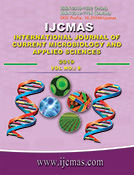


 National Academy of Agricultural Sciences (NAAS)
National Academy of Agricultural Sciences (NAAS)

|
PRINT ISSN : 2319-7692
Online ISSN : 2319-7706 Issues : 12 per year Publisher : Excellent Publishers Email : editorijcmas@gmail.com / submit@ijcmas.com Editor-in-chief: Dr.M.Prakash Index Copernicus ICV 2018: 95.39 NAAS RATING 2020: 5.38 |
Agriculture describes routine activities related with weather change; water is centre point of whole components whether it is used for agricultural or non-agricultural process. Classification of land resource is on the basis of farming situation i.e. upland (Baadi, Tikra and Marhan), midland (Maal) and lowland (Gabhar). Revenue map incorporated with survey map for delineating land resources of the village in which upland, midland and lowland were classified on the basis of slope and soil depth pertaining crop growing capability. Water bodies counting and measurement was done by individual visit of farmer’s home to record the number and measuring dimension of water bodies (ponds, wells and bore wells) by tape. The PRA was an interactive process spreading over four months period with planning occurring on site. Based on soil survey data, soils of Tahkapal village were classified in to six series with maximum area (151.78 ha) under Marhan soils followed by Tikra (81.48 ha) and Gabhar (58.01 ha). The lowest area coverage was under Baadi (14.67 ha) but Maal had higher (34.41 ha) than that of Baadi. Among the techniques, farmers actively adopted improved varieties, direct seeded rice in place of transplanting, weed management, nutrient application with sowing in furrows. In offset of such huge quantity of rainfall; 39 wells and 24 ponds having capacity of 2276668.23 litres water could be stored into wells as much as 12198780.01 litres in ponds. Another side of in-situ water storing 17390900.02 litres through compartmental bunding. Midland (Inceptisols) had silt loam in texture, sub angular blocky in structure, 14.2% water holding capacity, 0.08 dSm-1 EC, whereas pH, available nitrogen, P2O5, and K2O were 6.02, 156, 16 and 290 kg/ha respectively for midland and lowland. The nutrient status was improved in pH (6.5), available nitrogen (192.4 kg/ha), phosphorus (8.4 kg/ha), potash (212.4 kg/ha) along with Ca 5.6 c mol (+) kg -1 and Mg 4.3 c mol (+) kg -1.
 |
 |
 |
 |
 |